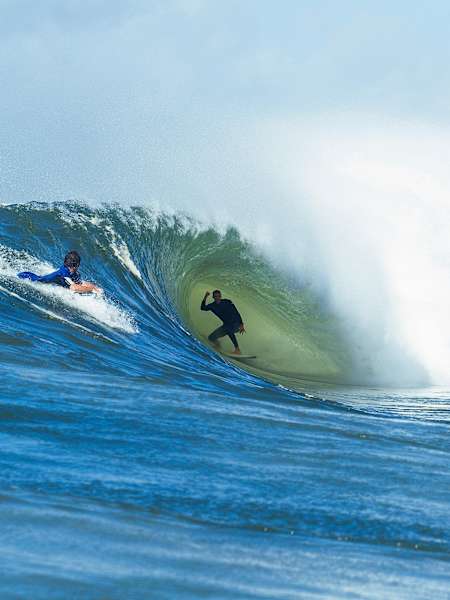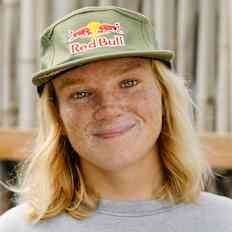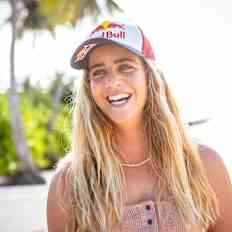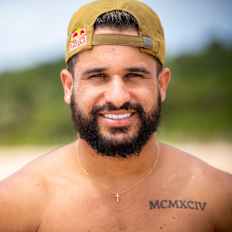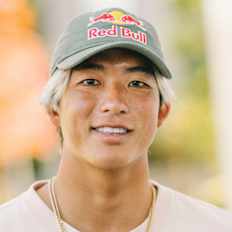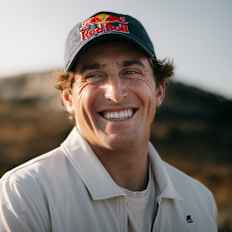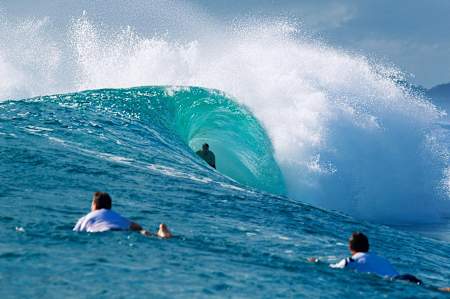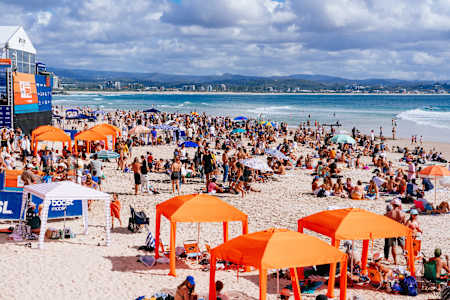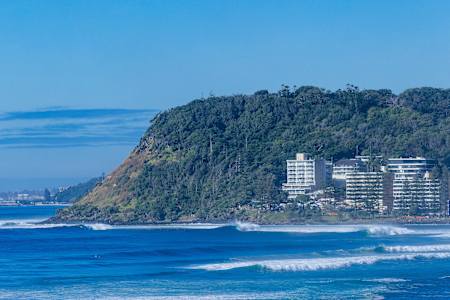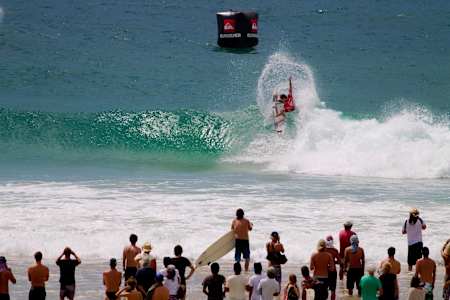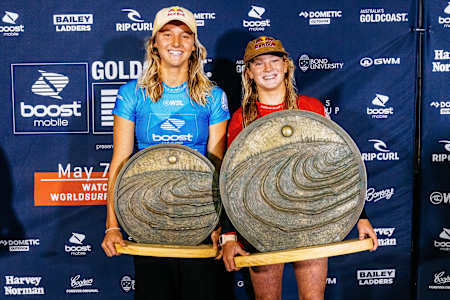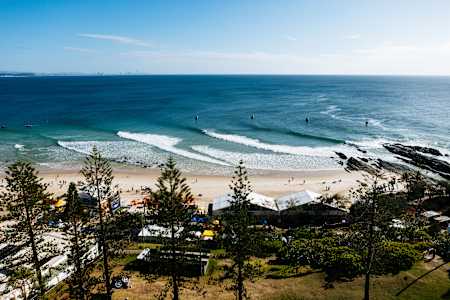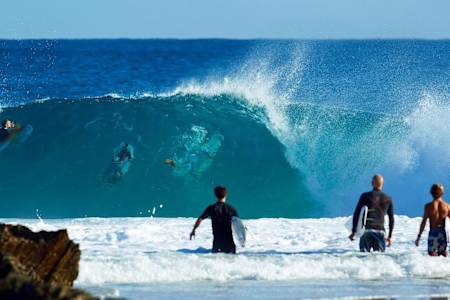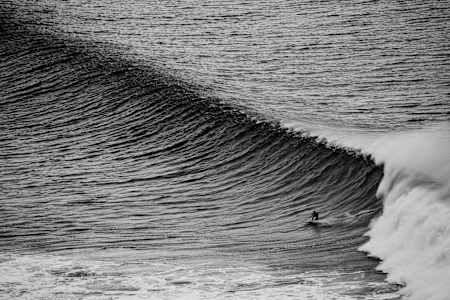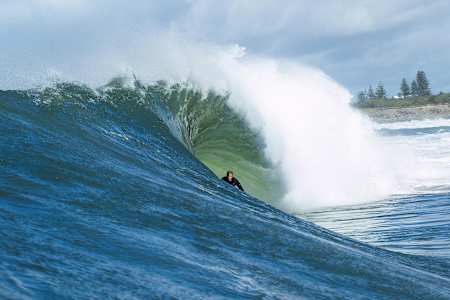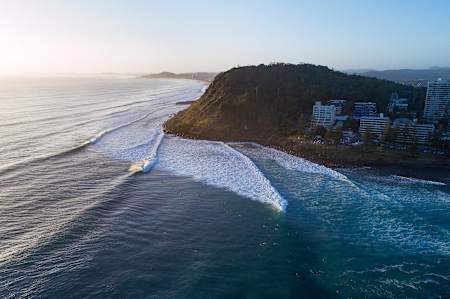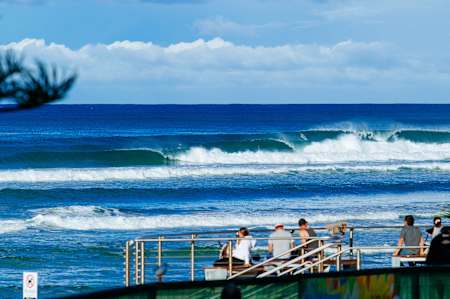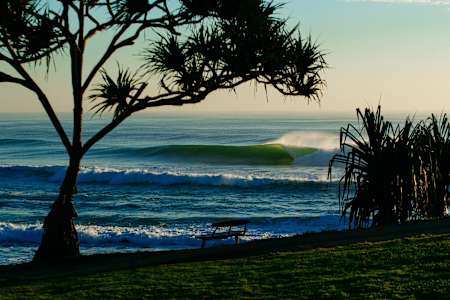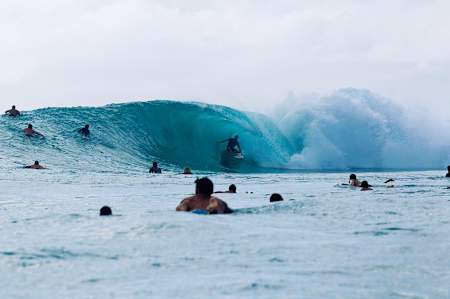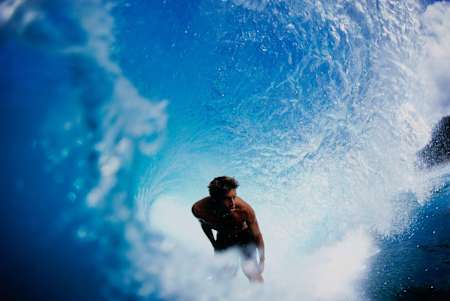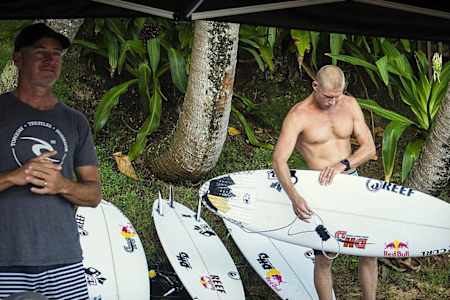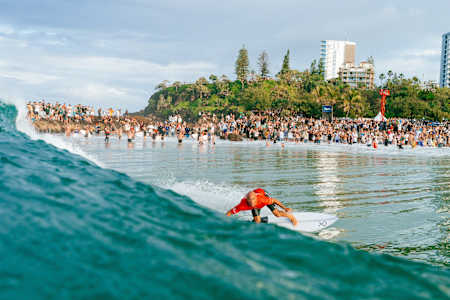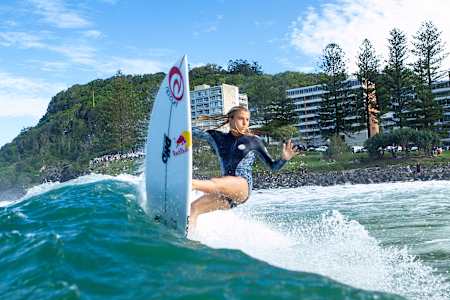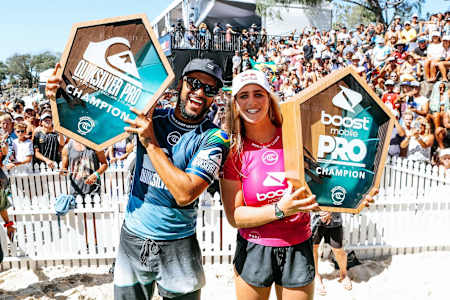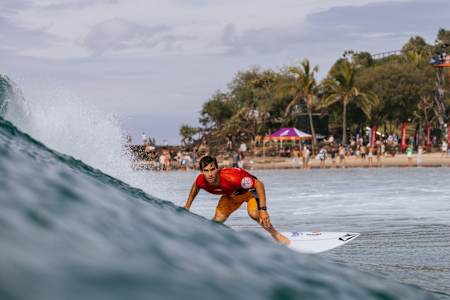Surfing
When Tropical Cyclone Alfred wreaked havoc on south-east Queensland in March this year, the much anticipated return of the Bonsoy Gold Coast Pro to the Championship Tour was derailed. Coolangatta, home of Snapper Rocks, was stripped of its sand, not only ruining the potential wave quality but meaning there was no longer a beach to house the infrastructure required to run a modern CT.
While the surfing world has been impatiently awaiting the return of Snapper Rocks to surfing's major league, Burleigh Heads, the birthplace of surfing's heat format, might just prove itself as the World Surf League's ultimate Plan B.
Watch live right here:

WSL Bonsoy Gold Coast Pro Finals
All that glitters is gold on finals day at the Bonsoy Gold Coast Pro.
01
Why the Gold Coast Pro is surfing’s ultimate showcase
While the Gold Coast is one of the great places to chase a life aquatic, any surfer worth his salt will tell you that the central tourist zone of Surfers Paradise fails dismally to live up to its name. The best waves are found along a 15km stretch to the south, from Burleigh Heads to Coolangatta and the many points in between.

14 min
The Ripple Effect: Cooly Kids
How has Coolangatta, population 5k, produced more surfing champions than anywhere else on Earth?
Surfers of all abilities flock from all over the world chasing the warm water walls that serve everything from friendly rollers to below-sea-level tubes. Where the surfers go, so to do the backpackers and jet setters, the baristas and fashionistas, the boho hipsters and party animals. And when the WSL caravan rolls in and pitches its tents and big tops, standing on sizzling sand watching the world's best perform just metres off the beach becomes the hottest ticket in town.
While the Gold Coast Pro has moved from Snapper Rocks in 2025, the auditorium atmosphere is no less impactful at Burleigh Heads. Instead of a shoreline heaving with tanned specimens in swimwear, the iconic headland holds thousands of humans who pack out picnic blankets, play music, heckle passing joggers and generally have a grand old time from sun up to sundown.
Add in the best surfers in the world enjoying their favourite contest of the year and all of the fun, games and activations that come with it, and it'll be hard to work out if you're attending an elite sporting event or a music-festival-come-fashion-parade. What's not to love!
02
From champs to challengers and back again
While recent talk around the Gold Coast Pro has focused on the shift from Snapper to Burleigh, there are two other major storylines associated with the event's evolution that are more impactful than logistical. The Gold Coast Pro was a fixture on the Championship Tour from 2002-2019 before the pandemic saw it put on hold.
The Gold Coast Pro returned as a Challenger Series event in 2022, and now, in 2025, rejoins the Championship Tour with a fresh-faced field of competitors.

3 min
No Contest: Winners and losers on the Gold Coast
Surfing's favourite undercover series is back as the action heats up on the Gold Coast.
Another major point of difference at this year's event is where it sits on the calendar. For years the Gold Coast Pro was the traditional season-opening jewel of the Championship Tour, a glamorous location for the coronation of world champs and a launchpad for rookies to announce themselves on the big stage. Surfers started the year with a clean slate, little on the line and, with the Australian surf industry still celebrating summer, the parties were superb.
In 2025 the Gold Coast plays a different role in the CT's make-up as event six, just before the mid-year cut. From curtain raiser to cut-line, the 2025 Gold Coast Pro will now be more consequential than celebrated. Whether performances elevate with the stakes or collapse under pressure, remains to be seen, but this will be a Gold Coast Pro like never before.
03
How a cyclone ushered pro surfing back to Burleigh Heads
When Tropical Cyclone Alfred started spinning in the Coral Sea in March the WSL couldn't have imagined the ripple effects would be felt in May, but here we are. Cyclones regularly light up Australia's north, but not since Tropical Cyclone Zoe in 1974 had one made landfall in south-east Queensland.
The results were devastating, and in the scheme of things losing sand and having to move a sporting event is relatively minor, but almost immediately competition organisers realised without the prime real estate afforded by the beach, there could be no Red Bull Athlete Zone, no judging tower, no grandstands, big screens, no parking for athletes and officials, and all the rest of the non-negotiables that lurk above the high tide line.
Enter Burleigh Heads, a heaving righthand tube just 15km to the north, heavily guarded by local surfers but once regarded as the home of one-on-one surfing. More recently known for hosting the annual Burleigh Single Fin – a fun, fiercely-fought contest atop 1980s surfboards – and the Australian Boardriders Battle – where the nation's best club sides lock horns – the return of the WSL to Burleigh completes a circle nearly 50 years in the making.
This wasn’t a step down. Burleigh Heads has long been a Gold Coast icon, serving up reeling righthand tubes over shallow sandbanks. The wave is raw and powerful and, sandwiched between a National Park and a sharp skyline, a marvel of contrasting aesthetics that makes it one of the best places in Australia to watch surfing live.
Burleigh is a wave with history, too. It was the home of the Stubbies Surf Classic, widely regarded as the Gold Coast's first major international event, from 1977 to 1988, using Peter Drouyn's man-on-man heat format, and it has hosted countless local, regional, and Qualifying Series contests in the years since. In 1999 Burleigh was the site of a women's standalone Championship Tour event, won by Australian seven-time world champion Layne Beachley.
In 2025, Burleigh Heads won’t just fill the gap left by Snapper Rocks, it will remind the world of its standing in the surfing world. For older fans this year's Gold Coast Pro will be a blast from the past, for younger surfers, an introduction to a shallow tube with a deep legacy.
04
All you need to know about Snapper Rocks and Burleigh Heads
Burleigh Heads and Snapper Rocks are both sand-bottomed righthand barrels, the kind that kids have drawn on their schoolbooks for years. They are both on the Gold Coast, and have both been staples in the surfing world – whether in movies or magazines or competition venues – for years, but that's where the similarities end.

3 min
No Contest: Winners and losers on the Gold Coast
Surfing's favourite undercover series is back as the action heats up on the Gold Coast.
Snapper Rocks is known as the Superbank for a reason. Since the inception of the Tweed River Sand Bypassing Project in 2001 sand has been dredged from the river floor and deposited outside of the its mouth, ensuring boats can safely navigate the waterway. Prevailing southerly swells then push this sand north to fill up the bays of Duranbah and Froggies, before it rounds the corner and creates a mile-long, ruler-straight sandbank that starts at Snapper Rocks and runs past Rainbow Bay and Greenmount, down to Coolangatta, before finishing up at Kirra.

5 min
Down The Line – Mick Fanning
Mick Fanning narrates four minutes of all-time waves on Australia's Gold Coast.
Since its inception, the Superbank has been one of the modern wonders of the surfing world, producing tubes so flawless they regularly get compared to a wave pool. Often, the major danger at Snapper is the weight of numbers in the water, so attractive and accessible are the waves.
To reach the line-up at Snapper, 90 percent of the time you simply walk out through the keyhole, pick a gap in the waves, and paddle for 10 seconds or so. You are now sitting in the prime take-off position, hair still dry, looking around to see if you're sharing the line-up with Mick Fanning or Stephanie Gilmore. Life is good.
Burleigh Heads is a natural phenomenon, its sand banks come and go depending on recent weather patterns, swell conditions and storm fronts. It's far less predictable and therein lies some of its beauty. Locals will argue that its tube is much heavier, with far more severe consequences when things go wrong. As a contest wave it is far more fickle, less user-friendly, and depends on tides and winds and currents to line up just so. But when it clicks...
At Burleigh Heads you run through the national park, scramble over slippery basalt rocks when it looks like your chances of getting hurt are at their lowest, risk your shins and surfboard as you pray for a lull then jump into what you hope is deep enough water. You then paddle your heart out, with lungs burning, and duckdive an endless battery of closeouts until you're finally spat out somewhere down the end of the long line-up.
You battle a vicious, raging current to get back remotely close to where you would like to be, knowing that if and when you finally catch a half-decent wave you will most likely get dropped in on. Welcome to Burleigh.
Burleigh Heads comprises four main sections. Sharkies is the furthest around into the National Park, the most illusive, and can deliver heavy barrels on its day. Sharkies runs into the Cove, which is where most surfers choose to jump off the rocks, and which can serve up long running tubes. At the end of the Cove is the Point, a long speed run that can produce perfect pits and big turn sections, before the Rockbreak comes into play.
This is the most all-purpose section of Burleigh and works more readily on smaller swells, while allowing for everything from tubes to turns and even big airs. Expect a lot of the 2025 Gold Coast Pro to go down on the Rockbreak.
05
Burleigh Heads has shaped Australian surfing for decades
Burleigh Heads might lay claim to one of Australia's smallest National Parks, but it can also rightly brag about its oversized contribution to global surfing, long before it came to be the home of the 2025 Gold Coast Pro.
Burleigh Heads has always seen itself as a surfing village, a cornerstone of Australian surf culture built as much on its legendary wave as the people who live there, and who are as passionate about defending their patch in the water as they are about supporting their local community on land.
As mentioned above, as a result of the Stubbies Surfing Classic, Burleigh became known as the birthplace of man-on-man competition, and provided the stage for legends like Michael Peterson, Wayne Bartholomew and Mark Richards to first put their names up in lights. As well as competitive animals, zen masters like Joe Engel, Cheyne Horan and Dave Rastovich honed their acts in Burleigh's emerald green tubes, before drawing their unique lines on canvases the world over.
While Burleigh's influence on competitive surfing is beyond doubt, so too is its impact on the global surf industry. Iconic Australia brand Billabong was born in Burleigh in 1973, founder Gordon Merchant and wife Rena hand-stitching boardshorts in their kitchen, then selling them to the world. Over 50 years later brands like Rhythm are following in Billabong's footsteps, while Quiksilver has moved their Australian operations from Torquay to the Gold Coast.
Burleigh has influenced foam and fibreglass as much as it has fashion, with an army of legendary surfboard shapers plying their trade in the area. Hot Stuff – surfboard of choice for Wayne Bartholomew – proved a nursery for shapers like Geoff McCoy, Al Byrne and Nev Hyman, while Dick Van Stralen and Chris Garrett developed a reputation for pushing creative design to its limits, achieving wild results along the way.
Speaking of results, Burleigh shaper Darren Handley can lay claim to a staggering 11 world titles won atop his DHD boards, thanks to Gold Coast greats Mick Fanning and Stephanie Gilmore.
06
Champions of the past vs the faces of today’s Championship Tour
In 2002, one year after the Superbank was born, the Gold Coast Pro became a Championship Tour event for the first time, and the two have been synonymous ever since. Legendary performances from the likes of Kelly Slater and Taj Burrow, and Gold Coast stars Stephanie Gilmore, Mick Fanning and Joel Parkinson put Snapper Rocks on the world surfing map.
The full house sign goes up early when Kelly Slater hits the line-up
© Andrew Shield/World Surf League
This was followed soon after by the arrival of the next generation of Aussies, Owen Wright, Matt Wilkinson and Julian Wilson all claiming Gold Coast Pro glory, squaring off against fellow Snapper champions, the Brazilian Storm of Gabriel Medina, Filipe Toledo and Italo Ferreira.
Fast forward to 2025 and a whole new crop of surfers have assembled in Queensland. Only 11 of the current men's Top 22 have competed in the Gold Coast Pro as a Championship Tour event before, while the women's ratio drops under 50 percent with just five of 11 surfers having competed previously. Of the "new" surfers however, Caity Simmers, Samuel Pupo and Erin Brooks all hoisted the trophy on the Challenger Series, en route to qualifying for the Championship Tour.
Caroline Marks and Italo Ferreira are, technically, defending event champions, after winning the last time the Gold Coast Pro ran on the Championship Tour in 2019, but the next generation are ready to assume control of the podium.
Gold Coast resident Jack Robinson is coming in hot after a win at Bells
© Andrew Shield/World Surf League
Can Griffin Colapinto improve on his third placing in 2018? Can local resident Jack Robinson continue his run of recent form and deliver on the hype around his first Gold Coast CT showing? What of Caity Simmers, Molly Picklum and Erin Brooks?
There are many questions to be answered at this year's Bonsoy Gold Coast Pro but one thing is certain, you won't want to miss a minute of the action on Red Bull TV, from May 3-13. Enjoy!
Part of this story

